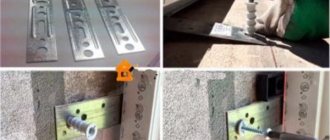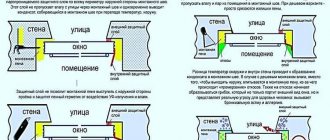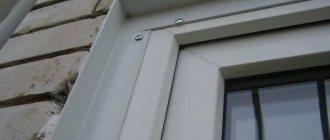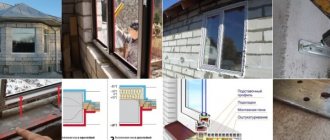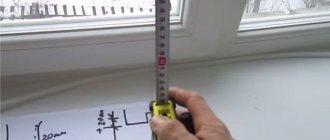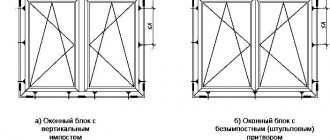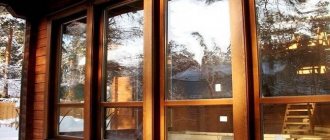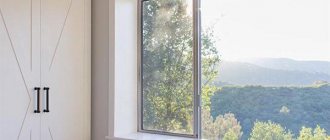Page 2 - continued. Start - on page 1
Scheme of sealing the installation seam of a plastic window in the opening of the outer wall of the house
1 - 2 - 3 - 4 - central, outer, inner and additional layers of sealing in the assembly seam;
5 - low tide; 6 - window sill For sealing, the installation seam must be filled with sealing materials in three layers - outer, central and inner. Moreover, each layer performs its own specific tasks. For each of them, different materials with the necessary properties are used.
The outer sealing layer (item 2 in the figure) can have additional weather protection in the form of special profile elements, rainproof strips, linings, etc.
On the inside, the installation seams are covered with a layer of plaster or cladding parts for window slopes and a window sill.
In the lower part of the window opening, protection from atmospheric influences is additionally provided by the ebb (item 5 in the figure).
To fill installation joints, silicone sealants, pre-compressed PSUL sealing tapes, insulating polyurethane foam cords, foam insulation, mineral wool and other materials that have a hygienic certificate and provide the required performance characteristics of the joints are used.
The sealing of installation gaps around the entire perimeter of the window must be tight, airtight, and designed to withstand climatic loads outside and operating conditions indoors.
Requirements for the outer layer of the assembly seam
The outer layer of the assembly seam should:
- Be waterproof when exposed to rain and a given (calculated) pressure difference between the outer and inner surfaces of the assembly seam. The water permeability limit of the installation joint must be at least 300 Pa.
- Have low water absorption, no more than 4% in 12 hours.
- Do not interfere with the removal of vaporous moisture from the central layer of the seam. The vapor permeability value of the outer layer of the seam should be no more than 0.25 m·h·Pa/mg.
- Be resistant to operating temperatures.
- Have sufficiently strong adhesion (adhesion) to the material of the wall opening and the window block with a sealant contact layer width of at least 3 mm.
- The thickness of the sealant layer after shrinkage must be at least 3 mm. The sealant layer in the outer layer should not be made very thick, as this increases the resistance to vapor permeation.
- Do not have cracks, the sealant layer must not delaminate or peel off from the materials of the installation seam.
In many cases, it is convenient to use PSUL sealing tapes as the outer layer of the assembly seam. Material specifically designed for this purpose.
Sealing tapes PSUL
PSUL is a pre-compressed sealing tape for sealing installation seams of a plastic window.
On the left without side impregnation. On the right with side impregnation. 1 - polyurethane base; 2 - adhesive layer reinforced with glass fiber (or without reinforcement); 3 - protective anti-adhesive film; 4 - side impregnation; S - width; H is the maximum thickness with free expansion; h - working thickness in the compressed state Pre-compressed sealing tape PSUL: pre-compressed elastic porous material based on polyurethane in the form of a tape, usually of rectangular cross-section, impregnated with special compounds. An adhesive layer is applied to one side of the sealing tape, which can be reinforced with glass fiber (or other material) and protected with an anti-adhesive film.
Sealing tapes are used to install an external waterproofing, vapor-permeable layer of assembly seams at the junction points of window blocks to the walls of buildings.
In cases where sealing tapes are used to seal the installation gaps of windows intended for operation with increased wind (for example, in high-rise construction), noise and other loads, the seams with sealing tapes should be covered with protective profiles , overlays, flashings, etc.
When opening and unwinding the roll, the sealing tape goes into a free state, while its width should not change, and the thickness should increase to the size of the optimal gap indicated in the tape marking. The time for restoring the tape thickness to the working expansion value at a temperature of plus 20 ° C is from 10 to 60 minutes.
Water resistance limit during operating compression of the sealing tape, Pa, not less: class A over 600; class B 400 - 600; class B 200 - 399.
Depending on their resistance to sub-zero temperatures, sealing tapes are divided into types of execution:
- I - for areas with an average monthly air temperature in January of up to minus 10 ° C;
- II - for areas with an average monthly air temperature in January from minus 10 °C to minus 20 °C;
- M (frost-resistant version) - for areas with an average monthly air temperature in January below minus 20 ° C.
The vapor permeability coefficient for tapes in a state of working compression is not less than 0.14 mg/m·h·Pa.
Sealing tapes must be durable and resistant to climatic factors, including UV radiation.
The durability of sealing tapes used for installation of window units must be at least 25 conventional years of operation.
The packaging of the sealing tape must indicate its water resistance class, as well as the width of the tape and the range of optimal sizes (or optimal size) of the gaps to be sealed.
When working with sealing tapes, use the following sequence of installation operations:
- Open the roll (roller) of the tape and cut off a technological allowance of 2-3 cm from the edge of the tape;
- Unwind the roll (roller), while simultaneously removing the protective anti-adhesive film from the tape;
- Glue the sealing tape with the self-adhesive side to the surface of the building structure, and the excess length of the tape should be 1 cm per 1 m of length (the joints are made at right angles);
- Install the window block in the opening, ensuring that the required gaps are observed and the necessary working compression of the sealing tape.
The tape is glued to one of the seam surfaces. When gluing the tape, do not pull it out or bend it in the corners of the opening. All corner and longitudinal connections of the tape are made end-to-end. The joined pieces of tape are pressed tightly against each other.
The sealing tape must not be painted, puttyed or plastered, as these additional coatings may impair its vapor permeability. The seam with sealing tape can be covered with flashings made of hard materials - plastic, metal or wood.
Watch the video on how to install a plastic window with seams sealed with sealing tapes:
Requirements for the central sealing layer
The central sealing layer must provide the required thermal characteristics of the assembly seam.
As a rule, polyurethane foam is used as the material for the central layer. The optimal width of the foam sealant layer is 15-60 mm, the depth is not less than the thickness of the window frame.
The resistance to vapor permeation of the central layer of the assembly seam must be in the range of values of this indicator for the outer and inner layers.
In the case of using frame profiles of window blocks with a width of more than 80 mm and if the width of the installation gap exceeds the dimensions provided for by this standard by more than 1.5 times, the gap should be filled in layers, with intervals between layers using the technology recommended by the manufacturer of the foam insulation.
The filling of the installation gap with heat-insulating materials must be continuous across the cross-section, without voids and leaks, breaks, cracks and overflows. Delaminations, through gaps, cracks, as well as holes larger than 6 mm are not allowed.
Requirements for the inner layer
The inner layer must ensure vapor permeability of the assembly seam.
The vapor permeability resistance of the inner layer must have a vapor permeation resistance value of at least 2.0 m·h·Pa/mg.
The materials used for the inner layer are mainly self-adhesive tapes and vapor barrier elastic sealants.
Vapor barrier materials along the internal contour of the installation gap must be laid continuously, without gaps, tears or un-glued areas.
When making the inner layer with a vapor barrier elastic sealant, the following requirements must be met:
- The contact surface of the sealant with the wall opening material and the window block must be sufficient to ensure the required adhesion strength. The width of the contact layer must be at least 3 mm.
- The thickness of the sealant layer after shrinkage must be at least 3 mm.
- The surface of the sealant should not have cracks, and the sealant layer should not delaminate.
An example from GOST of the installation seam of a plastic window in a three-layer wall (for example, with brick cladding) with insulation:
Installation seam of a plastic window in a three-layer wall with insulation: 1 - insulating self-expanding vapor-permeable tape (PSUL); 2 — anchor plate; 3 - foam insulation; 4 - vapor-tight sealant or vapor barrier tape; 5 — liner made of antiseptic lumber; 6 - dowel with locking screw
The window thickness of the three-layer wall is placed at the level of the insulation layer. A wooden liner is installed in the insulation layer around the perimeter of the window opening , pos. 5 in the picture.
Products for construction and repair
⇆
Additional sealing layer
An additional water-vapor barrier layer is installed to prevent moisture and steam from the wall material from penetrating into the junction unit and the assembly seam. For example, when installing windows in walls made of masonry materials to protect against process moisture.
To install an additional layer of sealing, insulating tapes, rolled materials, mastics or sealants are used.
The value of the vapor permeability resistance of the additional water and vapor barrier layer should not be lower than this indicator for the inner layer of the seam.
About the vapor permeability of the assembly seam
As stated in GOST, the internal and additional sealing layers must ensure vapor permeability of the assembly seam. The outer layer must be vapor permeable . And the resistance to vapor permeation of the central layer should be within the range between these indicators for the inner and outer layers.
Do you want to know where steam comes from in the wall and in the installation joint? And what happens if you don’t meet the standard requirements for vapor permeability of construction joint layers?
Read: “Dew point, vapor barrier and ventilated gap”
Removing the old frame
Once the room is ready for dust and debris to appear, begin dismantling the old window frame.
The sashes are removed from the window. Window casings are dismantled. If necessary, the slopes are dismantled (knocked down).
The old window frame is dismantled, which usually causes serious damage. If you want to use old windows, for example in a country house, you should specify the option of preserving the old windows when ordering.
The old sill and the old window sill are dismantled.
Preparatory activities
Before you start installing PVC windows, you need to prepare your workspace. Before starting the event, there are several aspects to remember:
- In order not to deviate from GOST standards, it is necessary to follow all stages of work carefully and accurately.
- For better adhesion, the work uses not water, but a primer.
First of all, you should clean the window sill, remove the curtains from the windows and remove all furniture located in the immediate vicinity of the window. It is advisable to cover the furniture with any convenient material, and the space under the window on the floor with newspapers or cardboard to prevent possible contamination.
The next goal is to eliminate the window, which needs to be replaced with a plastic one. You will need a hammer drill and an electric jigsaw, which will help you easily clean the surface down to the concrete or brick base.
Next, you can begin priming the slopes.
At this point, the preparatory activities can be considered completed.
Return to content
PVC window installation
The sashes are removed from the plastic window and the glass unit is removed. The window frame is inserted into the prepared opening and secured with anchor bolts or mounting plates. In this case, it is necessary to strictly ensure that the frame is level, and not along the opening (in houses there are often cases when the horizon line of the window opening is far from ideal; the frame should also be aligned vertically). Otherwise, the window will not function properly.
The gaps between the wall and the frame are foamed with polyurethane foam. Foam performs both an insulating function and is a fastening element. The overall result largely depends on the quality of this installation stage. The foam should be applied evenly and fill all the recesses and cavities of the opening, and the degree of expansion of the foam must be taken into account.
Installing a plastic window in most cases means that along with the new window a new window sill and a new sill will be installed. An exception is the case when the apartment (house, room) is undergoing renovation work and the window sill can be installed on its own.
If the window being mounted opens onto a balcony (as in this case), then it is quite practical and functional to install a window sill instead of a low tide (on the outside of the window).
If you have a good old sill, you can save it for a new window, but in this case you will need to restore it (restoration) - a paid service, the cost of which differs slightly from the cost of a new sill.
The window sill is cut to fit the opening and attached to the window (to the stand profile). If the opening under the window sill is small, then it foams. Otherwise, masonry or sealing of the opening with mortar is necessary. When installing a window sill board, make sure that it has an inclination from the window within 5 degrees, and that the overhang beyond the inner surface of the wall is no more than 60 mm.
When installing the window sill, you should take into account that its edges extend beyond the finishing of the internal slope to a depth of at least 15-20 mm.
Advice:
when choosing the width (depth) of the window sill, it should be taken into account that the window sill is “recessed” under the window frame by 2 cm, so the width of the installed window sill will be 2 cm less)
All gaps between the window and the opening are filled with foam, and when it dries, they are insulated. The outer layer of insulation is designed to protect the insulation layer (which is a layer of foam) from the penetration of moisture into it, as well as from the damaging effects of the sun.
So, the main part of the work is finished. However, to finish the opening there are not enough slopes (which are both a decorative addition, under which you can hide the mounting foam, and a functional element - increasing the thermal insulation and sound insulation of the window opening). Plastic slopes will give the window a finished look, moreover, this is the best combination with plastic windows.
Polyurethane foam
Polyurethane foam-based polyurethane foam is used to fill the seam between the frame and the opening. Once in a humid environment, under the influence of oxygen, the contents of the cylinder after a certain time form a solid, durable porous material that reliably fixes the window structure in a given position.
Using polyurethane foam, the window block is fixed in the opening
Polyurethane foam differs in seasonality of use: winter, summer and all-season
When installing PVC windows, it is important to use foam that has a low expansion coefficient - this will avoid deformation of the structure or disruption of its orientation in space
Due to the vapor permeability of this material, moisture escapes and the formation of condensation indoors is eliminated. And to protect the window structure and slopes from excess moisture, a special self-expanding tape is installed to cover the installation seam.
Installation of plastic slopes
Plastic slopes are installed on the same day as the window for panel and block houses and on the second day for Stalinist houses.
The slopes are either a Belgian sandwich panel (in the image) or German VEKA plastic slopes with removable trims.
The differences between the various plastic slopes are not significant, but you should know them.
The Belgian sandwich panel can be installed at dawn (not at a right angle to the window), which visually increases the window opening. The choice of VEKA plastic slopes is justified for more accurate wallpapering with already installed slopes. Thanks to the removable casing, the edges of the wallpaper will be neatly hidden under it.
Advice:
If you are renovating your apartment, then it is better to install platbands on the slopes from a Belgian sandwich panel after gluing the wallpaper yourself - it will turn out neater and prettier).
Preparing the mounting gap surface
Before installing insulating materials in the assembly joint, the surfaces of window openings and structures must be cleaned of dust, dirt, oil stains, and in winter conditions - from snow, ice, frost, followed by heating the surface with a construction hairdryer.
The edges and surfaces of external and internal slopes should not have chips, cavities, mortar overflows and other damage with a height (depth) of more than 10 mm. The voids in the wall opening should be filled with inserts of rigid insulation.
If there are defective areas resulting from removing old windows, they should be leveled and puttied with waterproof compounds (plaster mortar). In walls made of porous materials with significant water absorption, the surfaces of window openings should be treated with impregnating strengthening or priming compounds, or grouted with plaster mortar.
On the surface of the quarter and slopes in the area of gluing vapor barrier and vapor-permeable tapes, a primer is applied in 1-2 layers, which improves its adhesion to the tapes. The primer is applied with a brush or spatula in 1-2 layers.
To isolate the installation seam, after treating the surface of the window opening around the entire perimeter, it is recommended to install Izolon vapor barrier sealing tape.
If there is no quarter in the window opening for ease of installation, a false quarter is allowed (for example, using a corner made of weather-resistant polymer materials or metal alloys).
Installing accessories on windows
At the final stage, a double-glazed window is installed in the window frame and the sashes are hung. Additional accessories are installed, additional fittings and components are attached, such as: step ventilator, clamp, mosquito net, blinds, etc.
The window is ready. Upon completion of all work, a work acceptance certificate is signed. In it, if necessary, the customer indicates his comments on the work performed, if any.
Almost immediately after all the work is completed, the PVC window can be used. The exception is windows with large opening sashes, which are not recommended to be opened within 24 hours after installing a PVC window.
In terms of functionality, a plastic window is much better than old wooden windows. If you follow simple instructions for its care and use, it will last you forever.
Don't forget to remove the protective film from the outside of the PVC window!
According to GOST 30674 “Window blocks made of PVC profiles”: Removal of the protective film from the front surfaces of the profiles should be done after installing the products and finishing the installation opening, taking into account that the duration of exposure to sunlight on the protective film should not exceed ten days.
If renovation work is still underway in the room where the windows were installed, the protective film may remain on the product until completion. However, on the outside, the film should not be exposed to sunlight for more than 10 days.
The adhesive base of the protective film loses its properties when exposed to heat and UV and can spoil the aesthetic appearance of the plastic profile.
The following are comments from a specialist who participated in the development of GOST for window installation - A. Spiridonov.
GOST 30971-2002. Assembly seams of junctions of window blocks to wall openings. PDF, 1.26 MB
Possible mistakes
When creating installation seams and their design, beginners can make a number of mistakes that will lead to negative consequences. To prevent this from happening, professional installers and experts often share their experience on forums on the Internet, pointing out a number of important nuances :
- If the seam is too small - 10 mm or less - the foam layer will not be able to provide adequate resistance to heat transfer - the opening will need to be widened.
- If the gap is too large - more than 30 mm - the sealing materials begin to fall out, lose reliability during operation, and the entire structure does not have the proper strength. In such cases, it is recommended to plaster the opening on 3 sides, or install a high stand profile.
- Incorrect selection of polyurethane foam - the material must meet the operating conditions, as well as the device, depending on climatic conditions.
- Choosing PSUL tape with small dimensions - freezing and blowing of the window are possible. This material should be in a moderately compressed state in the gap.
- The use of low-quality sealing tapes - over time, the material may be destroyed under the influence of an aggressive environment.
- The use of diffusion protective tape with insufficient width means that the material will not be able to adhere along the entire contact plane, which will cause it to delaminate during operation and disrupt the thermal properties of the assembly seam.
Note. If you carefully follow the above recommendations and exclude the indicated errors, the window unit will be used for at least the period stated by the manufacturer, without the need for repair, restoration or replacement of structural elements.
General installation requirements according to GOST
GOST 30971-2002 “Mounting seams of junctions of window blocks to wall openings. General technical conditions" was put into effect by order of the State Construction Committee of the Russian Federation on March 1, 2003.
Due to the need to adjust design documentation for design and construction organizations, the transition period for the development of GOST is set until 07/01/2003. The republics of Azerbaijan, Kazakhstan, Kyrgyzstan, Moldova and Uzbekistan have joined the Russian standards.
What's new?
New standards bring significant formalization of window installation and require numerous documents. Among them, it should be noted the need for each installation room to have a window approved by local authorities, the need to develop window installation units for each facility under construction and coordination of units with the customer, it is recommended to analyze thermal fields, and also provides for the execution of acceptance certificates for window openings before installation, acts of hidden work and acceptance certificates of completed window installations.
Of particular interest in the standards are the Annexes:
- Appendix A (recommended) contains drawings with examples of window installation;
- Appendix B (recommended) sets out requirements for fastening windows in openings;
- Appendix B (mandatory) represents the actual requirements for the installation of windows as a whole and is essentially the main working document;
- Appendix D (recommended) describes the requirements for the method for calculating thermal fields (isotherm analysis).
In general, Russian installation standards bring us closer to the standards adopted in Europe, and, in particular, in Germany.
GOST requires a large number of formalities from window companies and has more requirements for testing joint designs and materials used for them.
Formalization is justified by the fight against Russian negligence.
Testing of materials and seams is generally justified by the fact that until now in Russia there were no detailed standards for installation at all, there is no accumulated scientific experience in determining the properties of installation materials and the quality of seams. Of course, there is no need for the consumer to know all the provisions of this GOST; this is the responsibility of professionals.
Without delving into the subtleties, we can talk about three basic principles for installing windows, to which you need to pay the closest attention.
Mounting tapes, what are they for?
During window installation, all empty space between the window system and the window opening is sealed using polyurethane foam to prevent drafts, leaks, and all that other stuff. But the foam has one important drawback: although its service life is about three decades, when it is directly exposed to ultraviolet radiation, the hardened foam is destroyed, simply crumbling. And if you do not take measures and take care to prevent ultraviolet radiation from entering the polyurethane foam, and also ensure the unhindered release of the resulting moisture to the outside, the polyurethane foam will simply collapse. Moreover, another reason due to which the layer of polyurethane foam will begin to collapse is moisture condensation inside the window seam. This happens due to a number of factors, such as temperature changes, use of the bathroom, cooking and similar factors that are present in any house or apartment. It is precisely to protect against such factors that a mounting tape is needed, which protects the seams of the mounting foam from destruction under the influence of negative factors, both outside and inside the room.
How do mounting tapes protect seams?
In order to prevent the impact of negative factors, a vapor-permeable self-expanding sealing tape, which in appearance resembles foam rubber, is used on the outside of the seam. This type of mounting tape is made of soft polyurethane, which, in turn, is impregnated with a specialized composition that has water-repellent properties, but retains the air-vapor permeability of the tape itself. This tape is used to protect the top and side sections of the sealing seam.
The part of the seam, which is located in the lower part of the window opening and is in direct contact with the drainage system, is insulated with tape with vapor-permeable and waterproofing properties. This tape prevents moisture from leaking and condensing.
To seal window seams from the inside of the room, tapes with a vapor barrier effect are used. Such tapes can be made on the basis of aluminum foil, which is applied to a non-woven material, with a base of rubber, which is also covered with a non-woven fabric. As a result, using this technology, the wear resistance of the seams increases and additional thermal insulation is created.
You can purchase tapes for window installation from the MTL-K company; they will offer you high-quality mounting tapes of European quality at the lowest prices.
Three layers of seam sealing
The content of the main part of the standards is devoted to the rules for filling the installation gap between window blocks and openings according to the principle “the inside is tighter than the outside.” Each installation unit must have three layers of sealing: on the outside - protection from climatic influences, in the middle - insulation, on the inside - vapor barrier. You can use different materials for the outer layers and different mounting foams, but, in one design or another, these three sealing planes must be present.
Outer layer
is designed to protect the insulation layer from moisture penetration into it, and must be vapor permeable in order for the insulation to be ventilated through it. That is, the outer layer must be waterproof and vapor permeable.
These requirements are due to the fact that when moisture penetrates into the insulation, its thermal insulation qualities decrease. PSUL (pre-compressed sealing tapes) best meets modern requirements for the outer layer. These are special mounting tapes that are glued to the window frame before installing it in the opening, and then, expanding, they fill all the leaks in the quarter in the opening.
Despite serious advantages: optimal construction physics and technological simplicity, they also have disadvantages. It is convenient to use these tapes in new construction when the opening has good geometry. But when replacing windows in old houses, when the slopes are uneven, and even more so, plastered, their use is difficult. Another drawback is that PSUL cannot be covered with plaster.
To a limited extent, silicone can be used outside. In this case, certain rules must be observed: the thickness of the silicone layer must be half the width of the seam being filled, and the silicone must be glued only on two sides and work in tension, the remaining sides must remain free.
Sealant can be used when insulating the installation seam. Although it is not clearly stated in GOST, there is no ban on its use, no matter how much the supporters of mounting tapes might want it. An example of using silicone outside and inside a room is shown in node A.14 in GOST 30971-2002. It is unacceptable, of course, as can sometimes be observed on objects, to simply spread silicone on top of the foam - this is an imitation of seam protection, but not the protection itself.
Central layer
– thermal insulation. Currently, polyurethane foams are used for its implementation. It is best to use foams designed specifically for window installation. Such foams fill the joint evenly and do not need to be trimmed after hardening. After installation, other foams hang in clumps from the side of the room, and they are cut off, breaking the protective outer crust.
Inner layer
– vapor barrier. Its function is to protect the insulation (foam) from the penetration of moisture vapor from the room. For these purposes, when plastering slopes, vapor barrier tapes, mainly butyl-based, are used, as well as paint-based vapor barriers for moisture-resistant plasterboards. It is possible to use silicone according to the rules mentioned above.
What materials can be used to cover it?
Sealing of seams is carried out with the following polymeric materials and elastic chemical compositions :
- Polyurethane foam:
- standard;
- fire-resistant - if there are special requirements for the window unit;
- resistant to temperature changes - for winter installation.
- Liquid or viscous sealants:
- silicone;
- polyurethane;
- acrylic;
- butyl;
- thiokol.
- Sealing tapes:
- PSUL - on the front side of the window structure;
- sealing tape - to improve the adhesion of PSUL to building structures;
- vapor barrier tape for sticking under low tide on the outside;
- vapor-permeable waterproofing membrane - for installation on the interior side of the window;
- diffusion tape - to protect the foam from the inside of the opening.
Note. When choosing sealing materials, special attention should be paid to their operating conditions and durability.
The best solution would be to purchase formulations from well-known manufacturers that have been on the market for a long time, whose products have many online reviews from satisfied consumers.
No cold bridges
An assembly seam is a node where the joining of wall and window structures, which have completely different properties, including in terms of heating technology, occurs. And it is important to make the knots in such a way that there are no cold bridges on the window slopes.
Basically, the problem of cold bridges is a problem of single-layer wall structures that were used in houses of past years (solid brick, expanded clay concrete, etc.). In this case, the weak area is the wall itself around the window frame due to its low heat transfer resistance. An area appears on the slope with a surface temperature below the dew point. In this area, firstly, high heat losses occur, and secondly, condensation occurs on it. If moisture condensation on a slope occurs frequently, then fungus (mold) may subsequently form in these places. The same applies to openings without quarters. In their absence, the danger of cold bridges seriously increases, and here the heating engineering of the junction units should be especially carefully considered.
An important recommendation is that if quarters are missing, use window frames with a width of at least 130 mm. With a narrow window frame, high-quality sealing of the seam is difficult and the likelihood of cold bridges is high. The options given in GOST with false quarters from the corners or from the platband are possible only with external plaster, and still remain problematic from the point of view of heating engineering.
If there is effective insulation in the wall (mineral wool or non-flammable polystyrene foam), the window should be placed either in the plane of the insulation or behind a quarter of the insulation. In walls where aerated concrete is combined with external cladding and brick quarters, as a rule, cold bridges also do not occur due to the good thermal properties of aerated concrete.
Application
Even though the air in the room seems dry, it contains a sufficient amount of moisture vapor. Often vapor barrier waterproofing is used in the construction of wooden houses.
Before insulating a building vapor barrier with staples, it is nailed to wooden buildings using a special stapler. Place the material so that it fits tightly, then seal the seams with adhesive tape.
In well-heated rooms, a vapor barrier is installed inside, and two layers of vapor barrier are made on the outside: on the inner and outer surfaces. This is done due to the fact that in summer the temperature outside is higher than in the building and steam, on the contrary, is directed from outside to inside, that is, into the room.
Fastening the window block in the opening
The specificity of plastic windows is that they have significant thermal linear expansion. That is, when windows are heated by the sun's rays, the bars of the frame and sashes increase in size. The calculated thermal expansion values for white windows should be 1.5 mm per 1 linear meter, for colored windows - 2.5 mm per 1 running meter (the difference in thermal expansion is due to the fact that white window profiles heat up significantly less than colored ones).
In accordance with this factor, the window is fastened to the wall. The corners of plastic windows must remain free; the outer fastening elements are placed at a distance of 150 mm from the inner corners of the frames. The remaining fasteners are placed around the entire perimeter with a pitch of no more than 70 cm for white profiles, and no more than 60 cm for colored profiles. Near the imposts, the fasteners are also placed at a distance of 150 mm from the corner. The gap between the frame and the wall must be at least 15 mm. This is due both to the thermal expansion of windows and to the fact that a thinner seam is very difficult to fill evenly with foam insulation.
Bearing blocks are placed under the lower corners of the box and under the imposts. The blocks are also placed on the sides as follows: if you look at the window from the inside, then with one turning sash, the blocks are placed on the side opposite the hinges at the top and on the same side as the hinges at the bottom. With two doors, four blocks are installed, respectively.
Schematic diagrams of junctions between window frames and walls
1 – window sill board; 2 – foam insulation; 3 – vapor barrier tape; 4 – flexible anchor plate; 5 – support block for the window sill board; 6 – plaster mortar; 7 – dowel with locking screw; 8 – liner made of antiseptic lumber or leveling layer of plaster mortar (recommended only for the lower unit); 9 – waterproofing, vapor-permeable tape; 10 – noise-absorbing gasket; 11 – drain; 12 – insulating self-expanding vapor-permeable tape (PSUL); 13 – thin layer of sealant
1 – foam insulation; 2 – insulating self-expanding vapor-permeable tape (PSUL) or vapor-permeable mastic; 3 – frame dowel; 4 – sealant; 5 – vapor barrier tape; 6 – panel for finishing the internal slope; 7 – plaster leveling layer of the internal slope.
Thermal gaps must be taken into account especially carefully when designing large-sized glazing elements: when making bay windows, shop windows, glazing to the entire height of the floor. These are the three main principles when installing modern windows, although, of course, there are many nuances and subtleties that depend on the different wall designs and on the materials used for sealing the seam. And - as we already said at the beginning of the article - the human factor is very important - responsible and high-quality work of installers.
Filling installation joints with polyurethane foam
- When the air temperature is above 0 oC, moisten the surface of the window opening using a spray bottle. In winter, before foaming, you need to check that the foam container is at room temperature (to do this, you can lower it into a bucket of hot water for a while).
- Screw a can of professional mounting foam onto the gun and shake well 10-15 times.
- Start filling the mounting seam with foam from the bottom up, holding the can upside down. If the installation seam is more than 50 mm wide or deep, it is better to fill it in several layers.
- When using professional foam, the seam is filled to 70%-80% of its depth. When using household foam (with an adapter), it is not recommended to fill the seam more than 40-50%, because this foam has high secondary expansion.
- Next, you need to fill the installation seam with foam around the perimeter of the window frame. When applying foam, the container must be shaken periodically - for better mixing of the components and a better foam yield.
- Fill the space under the window frame in accordance with the rules described above.
| Do not puncture or burn the container even after use! |
Deviations from vertical and horizontal
According to GOST 30971-2002 “Mounting seams of joints connecting window blocks to wall openings. General technical conditions", pp. 5.6.4 Deviations from the vertical and horizontal of the mounted window units should not exceed 1.5 mm per 1 m of length, but not more than 3 mm per product height.
In the updated version of GOST 30971 from 2012, the maximum deviations of the window and door unit from the vertical and horizontal levels are the same (clause 5.2.4) - no more than 1.5 mm per 1 m of length, and no more than 3 mm per height of the entire product .
How much does it cost to install windows according to GOST?
The cost consists of two components: the cost of work (hours) and materials.
The installation seam will comply with GOST for the installation of windows, when using both expensive and economical materials. The use of one or the other will affect the stages (duration) of the work and the final cost of window installation.
| Cost of installing a window unit, rub./sq. m | Cost of installation with finishing, rub./sq. m |
| from 900 rubles | from 1500 rubles |
Calculate by size
Quality assessment, control methods, guarantees
When accepting completed work (6), the following stages of control are distinguished:
- incoming – upon receipt of source materials;
- preparation of openings and blocks;
- meeting general installation requirements;
- operating;
- acceptance;
- laboratory with tests.
Test methods (7) consist in determining experimentally:
- Strength and adhesion of foam insulation.
- Deformation stability.
- Sizes and number of samples.
The presentation of the results is highlighted in a separate subsection.
